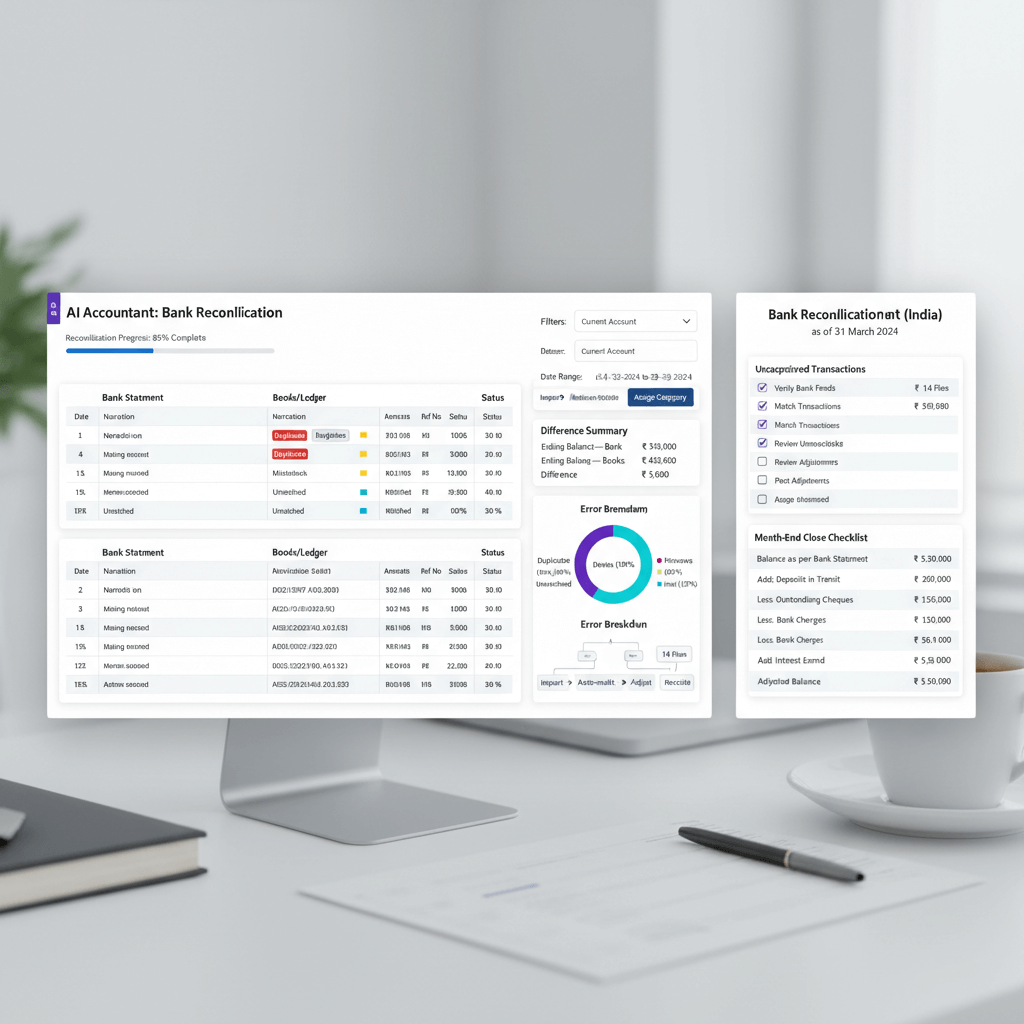Key takeaways
- Time savings: Automate TDS workflows to reduce manual effort by up to 80%.
- Accuracy: Eliminate calculation errors and avoid penalties with real-time rate application.
- Seamless integration: Connect accounting platforms like Zoho Books and Tally for frictionless data flow.
- Comprehensive compliance: Generate Forms 24Q/26Q, manage TCS, and calculate interest automatically.
- Scalability: Handle multi-entity operations and growing transaction volumes without added headcount.
Table of contents
- Key takeaways
- Introduction: The TDS challenge
- What is TDS and challenges of manual processing
- How TDS automation transforms compliance
- Auto deduct TDS bills
- TCS collection accounting
- Quarterly TDS return filing
- TDS interest calculator
- Key features to look for
- Top TDS automation software solutions
- Implementation best practices
- The ROI of TDS automation
- Common implementation challenges
- How AI Accountant enhances TDS compliance
- Future of TDS automation in India
- Choosing the right TDS automation solution
- Making the switch to automated TDS management
- FAQ
Introduction: The TDS challenge
Managing TDS compliance manually feels like drowning in paperwork. Every quarter, accountants and CFOs across India face the same nightmare:
Hundreds of vendor bills, complex rate calculations, and the constant fear of missing a deadline.
Fortunately, TDS automation software is reshaping this reality, turning late-night reconciliations into streamlined, error-free workflows.
What is TDS and challenges of manual processing
TDS (Tax Deducted at Source) mandates businesses to deduct tax on payments such as salaries, rent, contractor fees, and professional services. It ensures real-time tax collection, prevents evasion, and distributes the burden across the economy.
Relying on manual TDS processing leads to:
- Rate calculation chaos: Determining the correct rate based on payment type, PAN status, and thresholds.
- Data compilation nightmare: Matching invoices, challans, and PAN records across growing vendor lists.
- Quarterly filing stress: Late nights preparing Forms 24Q and 26Q and endless revisions.
- Penalty risks: Even a single miscalculation can trigger hefty fines and compliance notices.
Many teams now adopt the TDS automation with NetSuite approach to eliminate these headaches.
How TDS automation transforms compliance
Think of automation as your digital compliance assistant that never sleeps, never errs, and never misses a deadline.
- Smart transaction detection: Automatically flags TDS-applicable payments based on vendor type and thresholds.
- Accurate rate application: Applies real-time rates per current regulations and PAN status.
- Seamless integration: Connects with platforms like Zoho Books and Tally to eliminate manual entries.
- Automated form generation: Prepares statutory returns with data pulled directly from your accounting system.
Auto deduct TDS bills
Auto deduction transforms vendor payments:
- Intelligent payment processing: Flags invoices requiring TDS and applies correct rates based on rules.
- PAN status integration: Maintains updated PAN data to adjust rates for non-PAN vendors.
- Threshold management: Tracks cumulative payments, ensuring deductions kick in at appropriate limits.
- Real-time compliance: Every payment is compliant instantly, removing risks of missed deductions.
For example, paying a contractor ₹50,000 triggers a 2% TDS deduction (if PAN is available), automatically updating your ledger.
TCS collection accounting
Businesses subject to TCS also benefit from dual compliance:
- Automated TCS identification: Detects customer transactions requiring tax collection based on business type.
- Dynamic rate application: Applies correct TCS rates per goods or services provided.
- Collection reconciliation: Matches collected amounts with reported figures for transparent reporting.
- Integrated reporting: Combines TDS and TCS data into unified quarterly returns.
Quarterly TDS return filing
Traditional return filing is replaced by:
- Direct data integration: Pulls TDS data from your accounting system, eliminating manual compilation.
- Form 24Q and 26Q generation: Prepares forms automatically with pre-populated transaction details.
- Discrepancy detection: Flags mismatches like PAN inconsistencies or missing challan data.
- Portal integration: Connects with government portals for seamless e-filing and status tracking.
- Management reporting: Provides comprehensive overviews of TDS positions and pending filings.
TDS interest calculator
A built-in interest calculator helps manage late payments and penalties:
- Automatic penalty computation: Calculates interest based on current rates and deposit dates.
- Proactive alerts: Sends deadline reminders and penalty warnings.
- Liability tracking: Shows outstanding TDS amounts and accrued interest.
- Historical analysis: Tracks delay patterns to improve future compliance.
Key features to look for
- Multi-entity support: Consolidate TDS across multiple companies.
- Bank integration: Auto reconcile TDS payments via bank statement processing.
- Vendor management: Centralize PAN tracking, rate settings, and payment history.
- Compliance updates: Automatic regulatory and rate change updates.
- Audit trail: Detailed transaction history for audit readiness.
- Dashboard reporting: Real-time insights into TDS positions and pending actions.
Top TDS automation software solutions
Leading platforms in India include:
- AI Accountant: End-to-end financial automation with TDS, reconciliation, and dashboards.
- Saral TDS: Standalone TDS solution with strong filing and portal integration.
- ClearTax: Comprehensive tax platform including TDS automation.
- MasterGST: GST focus with integrated TDS compliance.
- Tally integrated solutions: Plugins enhancing Tally’s native TDS features.
- NetSuite TDS modules: Enterprise-grade solutions for complex requirements.
Implementation best practices
- Data migration strategy: Clean and validate historical TDS, vendor, and challan records.
- Integration testing: Ensure smooth data flow between your accounting system and the automation tool.
- User training: Equip your finance team to leverage full automation capabilities.
- Compliance verification: Run parallel manual checks initially to confirm accuracy.
- Backup procedures: Maintain secure backups of all TDS data and documents.
- Regular updates: Install software updates for new regulations and rate changes.
The ROI of TDS automation
- Time savings: Automate days of work into hours, freeing teams for strategic tasks.
- Error reduction: Eliminate human mistakes and avoid costly corrections.
- Penalty avoidance: Maintain compliance to reduce interest and fines.
- Scalability: Handle growing volumes without adding staff.
- Audit preparedness: Leverage audit trails and automated documentation.
Common implementation challenges
- Data quality issues: Invest in data cleaning to avoid setup delays.
- Integration complexity: Work with experienced partners for seamless connections.
- Change resistance: Use pilots and training to demonstrate benefits.
- Compliance updates: Select tools with automatic regulatory updates.
- Cost concerns: Evaluate total cost of ownership, factoring time savings and penalty avoidance.
How AI Accountant enhances TDS compliance
- Intelligent data processing: OCR and NLP identify TDS transactions in bank statements and invoices.
- Seamless Tally integration: Bi-directional sync ensures TDS entries update your books automatically.
- Automated reconciliation: Bank statement reconciliation includes TDS deductions and payments.
- Dashboard visibility: Real-time TDS positions alongside other financial metrics.
- Reduced manual work: Up to 75% reduction in TDS bookkeeping and reconciliation tasks.
Future of TDS automation in India
- AI-powered insights: Predict optimal payment timing to improve cash flow.
- Government API integration: Direct e-filing and status tracking without manual uploads.
- Blockchain verification: Immutable audit trails for TDS transactions.
- Mobile-first compliance: Manage and approve TDS on the go via mobile apps.
- Predictive compliance: Anticipate regulatory changes and adjust workflows proactively.
Choosing the right TDS automation solution
- Business size and complexity: Match solution sophistication with your entity count and transactions.
- Software ecosystem: Verify integration compatibility with existing ERP and accounting systems.
- Compliance scope: Assess current and future regulatory needs, including TCS obligations.
- Budget and ROI: Balance features with costs, focusing on long-term time and penalty savings.
- Support and training: Ensure vendor offers robust onboarding and ongoing assistance.
- Scalability: Choose a platform that grows with your business without frequent upgrades.
Making the switch to automated TDS management
- Start small: Pilot the solution on specific entities or workflows to prove value.
- Measure success: Track time savings, error rates, and penalty avoidance metrics.
- Invest in training: Ensure your team masters the tool to maximize benefits.
- Plan for growth: Select features that support expanding compliance complexity and transaction volumes.
FAQ
How do I set up TDS automation for multiple entities using AI Accountant?
AI Accountant allows you to configure separate entity profiles with distinct bank accounts, PAN records, and TDS thresholds. Simply upload your chart of accounts and vendor master for each entity, map TDS rules, and the system will apply appropriate deductions automatically across all profiles.
How can AI Accountant integrate with Tally for seamless TDS processing?
With bi-directional sync, AI Accountant maps your Tally ledger codes to TDS deduction accounts. Every payment recorded in Tally is mirrored in AI Accountant, which applies TDS rules, updates ledgers, and sends back compliant entries to your Tally books in real time.
What is the process to auto-deduct TDS bills using AI Accountant?
Upload vendor invoices or import them via API. AI Accountant identifies TDS-applicable transactions based on vendor PAN status and amount thresholds, applies the correct rate, deducts the tax, and generates ledger entries instantly.
Can AI Accountant generate Form 24Q and 26Q automatically?
Yes, AI Accountant compiles all TDS transactions for the quarter, populates Forms 24Q (for salaries) and 26Q (for other payments), and exports e-filing ready XML or PDF formats, complete with challan details and vendor PAN information.
How do I calculate TDS interest for late payments?
AI Accountant’s built-in TDS interest calculator computes penalties using current rates and actual payment dates. You receive automatic alerts for upcoming deadlines and warnings if any payments are delayed beyond due dates.
How to manage TCS collection alongside TDS in the same AI tool?
Enable TCS modules in AI Accountant and define the nature of goods or services subject to TCS. The system will flag customer invoices for TCS collection, apply dynamic rates, reconcile collections, and merge TCS data into your quarterly returns.
What features should a CA look for in TDS automation software?
A CA should evaluate multi-entity support, bank integration, automated rate updates, audit trail capabilities, vendor management, and seamless accounting platform integrations—features that AI Accountant provides out of the box.
How can I migrate my historical TDS data to AI Accountant?
Export your existing TDS records from your legacy system into CSV or Excel files, including challan numbers, dates, and PAN details. AI Accountant offers a guided data import wizard that validates and maps this history to your new system.
How does AI Accountant handle PAN non-compliance under Section 206AA?
You can define Section 206AA rules in AI Accountant so that non-PAN vendors automatically incur higher TDS rates. The system flags such vendors, applies the elevated rate, and includes warnings in your reports.
Is it possible to track TDS liabilities and challans in real time?
Absolutely. AI Accountant’s dashboard displays current TDS liabilities, deposited challans, pending payments, and accrued interest. You can filter by entity, vendor, or period for granular visibility.
How does real-time integration with bank statements work in AI Accountant?
AI Accountant connects securely to your bank feed, imports statement lines daily, matches payments to vendor invoices, applies TDS deductions, and reconciles automatically—ensuring your books and compliance data stay in sync.

-01%201.svg)



